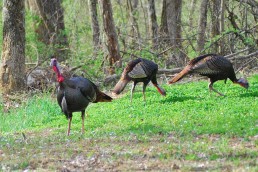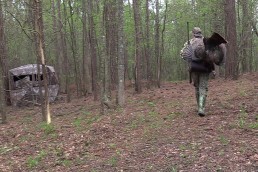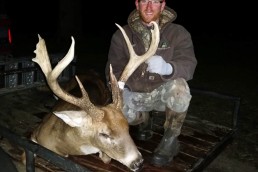Gobblers Make Mistakes, Too
SHARE THIS POST
There’s no doubt spring gobblers don’t play fair and can take more turns than a merry-go-round. Their actions often cause hunters to ask themselves questions, but if hunting turkeys were easy many could slay one every time. Certainly, wild toms can be frustrating, but that’s what’s so addictive. And if we shot every bird we pursued being afield might lose its zest.
Dealing with a tom’s response is challenging; a hunter needs to react to a jake approaching first or a tom rushing and then backing off or a bird creating a one-hour standoff. This is why turkey hunting is exciting—predictability is not the norm.
Once I was hiding along a hardwoods hillside hoping for a gobbler to approach my calling. Although one didn’t appear until late morning, once he did he cruised the top of an open ridge. I was certain I could coax him in for a clean shot. However, this bird my confidence was premature. Confidence had told me I had him because I was tucked into a weathered, massive, oak tree downfall. I was positive resident turkeys were familiar with its appearance, especially when a strutting tom seemed interested. I was sure he’d approach as he walked downhill. He was cruising the ridge top 80 yards above me. After his last gobbles, he yelped several times on my left side. As he was descending this leafy hillside he yelped with arrogance, working his way down the hill on my left. I knew I had him because I expected it to step into view. My shotgun was on my knee and ready.
This time I was wrong—the tom insulted me and disappeared within the woods. Without warning, I noticed a familiar shape after three subtle clucks. The gobbler was standing on my right side and I couldn’t move because he was looking directly at me. He had me. I watched him walk over the hillside, “putting” as he glanced back toward me. This rogue gobbler beat me, but I didn’t feel like a failure. I had to let him go because my shot might have wounded him. It was a lesson I’ll always remember: never underestimate a gobbler’s approach, and turkeys don’t always win.
If a gobbler has no breeding intensions he might be a ghost. But when mating hens are in the mood, just about any hen-like audible can turn them on. If ever I have faced an uncooperative gobbler, this was the one. The wind was gusting and I didn’t hear a gobble. Then I walked, stopped and listened for almost 10 minutes before I heard a faint gobble.
I guessed his location.
Suddenly, he appeared to be in a deep hollow, but didn’t gobble with intensity. I then moved to the top of a partially wooded ridgeline and sat down. I waited for several minutes. Then he gobbled with certainty. I hen-yelped between wind gusts and he answered right back. Within seconds, this tom was closer.
Then—nothing.
I ceased calling after I heard him walking again in the leaves behind me, spitting and drumming. He then circled my
backside. I didn’t move or call because I was facing an open pasture and couldn’t turn for a shot without him noticing my movement. The bird then passed to my right, gobbling one more time. Then it was silent again.
This had become a game of patience now. I was certain he was going to circle and come out in front of me.
Then, I saw him visible at the edge of a tangle of greenbrier. He studied the open field for several minutes.
Then it was on, as he strutted back and forth along the edge of the open field. His gobbling picked up frequency as he tried to intimidate me to make a move.
I cutt and then yelped.
The gobbler responded with “come-to-me” gobble. So, I stopped calling.
Are you enjoying this post?
You can be among the first to get the latest info on where to go, what to use and how to use it!
When his patience wore thin, he strutted toward me. After he committed, he strutted within 15 yards and I putted. When he stood up like an ostrich I shot the goofy gobbler. Fortunately, he was by himself. If he had been with hens, it would’ve been harder.
It was a tremendous turkey-hunting morning with even more gobblers eventually yelling aggressively. I was already sitting at my favorite spot on a hilltop now, beside an open meadow. The turkeys were now providing me with every vocal they create. And although the birds I heard were not close, I was certain there had to be more toms on the move.
Within minutes, I heard spine-tingling gobbles below me and to my right. I didn’t call—waiting to see if he was with hens. He moved circular, gobbling aggressively. Suddenly, it sounded as if there were two. A jake and a mature tom instantly approached me. I’ve always wondered why jakes and older toms hang out. It must be because the warrior gobblers learn to elude hunters and know how to use the various tricks. Some biologists believe it’s because an immature tom (jake) makes a mature tom look superior. Possibly, the mature tom uses a jake as a pawn to keep him void from predators and human hunters, too.
I now noticed movement as one tom strutted in from my right. My shotgun was in position. I purred, and then clucked and he triple-gobbled. I carefully lowered my cheek to the receiver of my shotgun and waited for him to appear. He was far enough away that I moved my left hand to reach for another diaphragm call.
I had screwed it up. “Putt-putt.” There were two gobblers and the other tom was standing behind me. I’ve learned that no matter how obvious any turkey encounter is you always need to be aware of your surroundings. Both birds ran off putting. This time, two birds had beaten me.
During the final stretch of the hunt I was standing at the edge of a dense woods before daybreak, with no turkey vocals. I waited for 15 minutes—nothing.
Later, just as I was leaving to drive to another hunting location a tom gobbled. It was later than I expected. Fortunately, he picked up in his intensity. I made my move, sliding down a steep slope and into a grassy ravine. I walked until I guessed I was 80 yards from his gobbling and selected a cluster of trees to hide within.
He gobbled for several more minutes.
Then—silence.
Patiently, I waited until the tom was vocal again. When he gobbled he was closer, and on my left. I waited. Then I heard a jake with his weak gobbles. The two birds appeared to be together, with no hens. So, I clucked.
They now both gobbled. Tucked in between two trees, the jake appeared first. It was an easy shot, but mature toms are notorious for letting jakes check out potential hens.
The jake was hot, gobbling as young toms do. He circled me, looking everywhere. I didn’t call and let the young tom walk past me before I finally I shot the mature tom behind him.
Wild turkeys are predictable and stupid, right? I’ve learned that this is not true. In fact, many hunting experiences like these will teach many hunters that every encounter is survival of the craftiest.
MWO
SHARE THIS POST
Did you enjoy this post?
You can be among the first to get the latest info on where to go, what to use and how to use it!
Bob Grewell
Bob “Greenie” Grewell has written about and photographed the outdoors for 40 years. He’s travelled throughout the U.S., Canada, the Arctic Circle, as well as Germany and Denmark. He has written a book on hunting dogs and contributed articles and photography to others. He currently focuses on deer and turkey articles, and wildlife photography.



